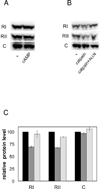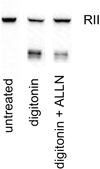Proteolytic regulation of the mitochondrial cAMP-dependent protein kinase
- PMID: 22385295
- PMCID: PMC3309167
- DOI: 10.1021/bi201573k
Proteolytic regulation of the mitochondrial cAMP-dependent protein kinase
Abstract
The mitochondrial cAMP-dependent protein kinase (PKA) is activatable in a cAMP-independent fashion. The regulatory (R) subunits of the PKA holoenzyme (R(2)C(2)), but not the catalytic (C) subunits, suffer proteolysis upon exposure of bovine heart mitochondria to digitonin, Ca(2+), and a myriad of electron transport inhibitors. Selective loss of both the RI- and RII-type subunits was demonstrated via Western blot analysis, and activation of the C subunit was revealed by phosphorylation of a validated PKA peptide substrate. Selective proteolysis transpires in a calpain-dependent fashion as demonstrated by exposure of the R and C subunits of PKA to calpain and by attenuation of R and C subunit proteolysis in the presence of calpain inhibitor I. By contrast, exposure of mitochondria to cAMP fails to promote R subunit degradation, although it does result in enhanced C subunit catalytic activity. Treatment of mitochondria with electron transport chain inhibitors rotenone, antimycin A, sodium azide, and oligomycin, as well as an uncoupler of oxidative phosphorylation, also elicits enhanced C subunit activity. These results are consistent with the notion that signals, originating from cAMP-independent sources, elicit enhanced mitochondrial PKA activity.
Figures







Similar articles
-
Probes of the mitochondrial cAMP-dependent protein kinase.Biochim Biophys Acta. 2013 Jul;1834(7):1359-63. doi: 10.1016/j.bbapap.2013.02.002. Epub 2013 Feb 11. Biochim Biophys Acta. 2013. PMID: 23410952 Free PMC article.
-
Oxidative stress induced mitochondrial protein kinase A mediates cytochrome c oxidase dysfunction.PLoS One. 2013 Oct 10;8(10):e77129. doi: 10.1371/journal.pone.0077129. eCollection 2013. PLoS One. 2013. PMID: 24130844 Free PMC article.
-
Modulation of regulatory and catalytic subunit levels of cAMP-dependent protein kinase A in anterior pituitary cells in response to direct activation of protein kinases A and C or after GnRH stimulation.Neuroendocrinology. 1995 Nov;62(5):514-22. doi: 10.1159/000127042. Neuroendocrinology. 1995. PMID: 8559283
-
Swimming regulations for protein kinase A catalytic subunit.Biochem Soc Trans. 2019 Oct 31;47(5):1355-1366. doi: 10.1042/BST20190230. Biochem Soc Trans. 2019. PMID: 31671183 Review.
-
Protein kinase A: regulation and receptor-mediated delivery of antisense oligonucleotides and cytotoxic drugs.Ann N Y Acad Sci. 2002 Jun;968:158-72. doi: 10.1111/j.1749-6632.2002.tb04334.x. Ann N Y Acad Sci. 2002. PMID: 12119275 Review.
Cited by
-
Human Ovarian Cancer Tissue Exhibits Increase of Mitochondrial Biogenesis and Cristae Remodeling.Cancers (Basel). 2019 Sep 12;11(9):1350. doi: 10.3390/cancers11091350. Cancers (Basel). 2019. PMID: 31547300 Free PMC article.
-
Zagociguat prevented stressor-induced neuromuscular dysfunction, improved mitochondrial physiology, and increased exercise capacity in diverse mitochondrial respiratory chain disease zebrafish models.Front Pharmacol. 2025 Jul 25;16:1588426. doi: 10.3389/fphar.2025.1588426. eCollection 2025. Front Pharmacol. 2025. PMID: 40786033 Free PMC article.
-
Noncanonical protein kinase A activation by oligomerization of regulatory subunits as revealed by inherited Carney complex mutations.Proc Natl Acad Sci U S A. 2021 May 25;118(21):e2024716118. doi: 10.1073/pnas.2024716118. Proc Natl Acad Sci U S A. 2021. PMID: 34006641 Free PMC article.
-
Probes of the mitochondrial cAMP-dependent protein kinase.Biochim Biophys Acta. 2013 Jul;1834(7):1359-63. doi: 10.1016/j.bbapap.2013.02.002. Epub 2013 Feb 11. Biochim Biophys Acta. 2013. PMID: 23410952 Free PMC article.
-
Neurotoxic mechanisms by which the USP14 inhibitor IU1 depletes ubiquitinated proteins and Tau in rat cerebral cortical neurons: Relevance to Alzheimer's disease.Biochim Biophys Acta Mol Basis Dis. 2017 Jun;1863(6):1157-1170. doi: 10.1016/j.bbadis.2017.03.017. Epub 2017 Apr 1. Biochim Biophys Acta Mol Basis Dis. 2017. PMID: 28372990 Free PMC article.
References
-
- Manning G, Whyte DB, Martinez R, Hunter T, Sudarsanam S. The protein kinase complement of the human genome. Science. 2002;298:1912–1934. - PubMed
-
- Gullingsrud J, Kim C, Taylor SS, McCammon JA. Dynamic binding of PKA regulatory subunit RI alpha. Structure. 2006;14:141–149. - PubMed
-
- Kim C, Xuong NH, Taylor SS. Crystal structure of a complex between the catalytic and regulatory (RIalpha) subunits of PKA. Science. 2005;307:690–696. - PubMed
-
- Zhong H, SuYang H, Erdjument-Bromage H, Tempst P, Ghosh S. The transcriptional activity of NF-kappaB is regulated by the IkappaB-associated PKAc subunit through a cyclic AMP-independent mechanism. Cell. 1997;89:413–424. - PubMed
-
- Dulin NO, Niu J, Browning DD, Ye RD, Voyno-Yasenetskaya T. Cyclic AMP-independent activation of protein kinase A by vasoactive peptides. J Biol Chem. 2001;276:20827–20830. - PubMed
Publication types
MeSH terms
Substances
Grants and funding
LinkOut - more resources
Full Text Sources
Miscellaneous

